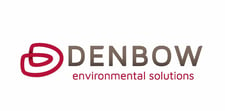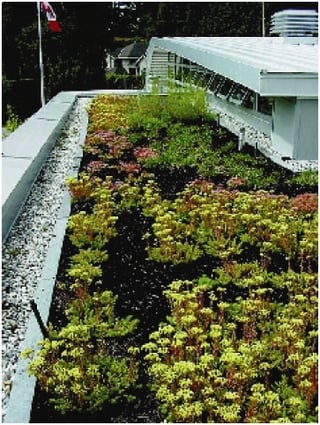Green roofs, walls and facades are becoming more common in cities across the globe. "Green roofs and walls provide a wide range of environmental, economic and social benefits, both public and private. They can reduce urban heat loadings and stormwater run-off, increase the energy efficiency and livability of buildings, provide a range of habitat outcomes and even produce food. These guidelines will help to develop an understanding of the technology and build knowledge about the benefits and methods of green roof/wall/facade design, construction and maintenance for all sectors of the industry." Sidonie Carpenter, Growing Green Guide
Many cities around the world recognize the importance of having green infrastructure; that is, natural landscape assets, including green spaces and water systems. Green infrastructure includes trees, parks, water sensitive urban design (such as wetlands and rain gardens) and green roofs, walls and facades.
 Green roofs, walls and facades are appealing as a way of adding green infrastructure to a city because they can be included on new buildings or retrofitted onto existing buildings, and require little, if any, space at ground level. They are being used to compensate for the loss of urban greenery, and to provide localized cooling and aesthetic improvements in dense urban centres where there is insufficient space for other types of green infrastructure.
Green roofs, walls and facades are appealing as a way of adding green infrastructure to a city because they can be included on new buildings or retrofitted onto existing buildings, and require little, if any, space at ground level. They are being used to compensate for the loss of urban greenery, and to provide localized cooling and aesthetic improvements in dense urban centres where there is insufficient space for other types of green infrastructure.
What is a Green roof?
A vegetated landscape built up from a series of layers that are installed on a roof surface as ‘loose-laid’ or modular (that is, installed layer by layer on the roof or as pre-prepared layers in trays).
Green roofs are constructed for multiple reasons – as spaces for people to use, as architectural features, to add value to property or to achieve particular environmental benefits (for example, stormwater capture and retention, improved species diversity, insulation of a building against heat gain or loss).
Vegetation on green roofs is planted in a growing substrate (a specially designed soil substitution medium) that may range in depth from 50 mm to more than a metre, depending on the weight capacity of the building’s roof and the aims of the design.
Frequently Asked Questions
Do green roofs work on new and old buildings?
Yes. Green roofs can be fitted to a range of roof types. A new building can be constructed to accommodate the weight loading necessary for a green roof. Some existing buildings will have the capacity to support a green roof, or additional structural support can be retrofitted to support the required increase in loading. A structural engineer must be engaged to clarify details of building structure and weight loading capacity.
Can I green any building?
Most building surfaces have the potential for greening. Challenging sites such as those in deep shade or with low weight-loading capacity, and tall buildings or sites with limited access, require specialist engineering, design and technical input.
Is irrigation necessary for a green roof, wall or facade?
All green walls and most green facades and roofs, require irrigation. It is possible to install a green roof with no irrigation, but this will limit the range of plants that can be used successfully and the potential benefits of the roof (such as summer cooling or aesthetically pleasing views of leafy plants). Some green facades grown in garden bed settings may not need irrigation.
Can I have a green roof on a slope?
Yes, but steeper slopes present a challenge, and require specialized design solutions, including drainage boards and systems to help hold substrates and plants in place.
How much water do you need?
There is no one answer, as calculating the water needed to sustain a green roof, wall or facade depends on climate and environmental influences, the design and type of system used, and on the substrate and vegetation characteristics. Explore alternative sources of water for use in irrigation, such as harvested and recycled water, to minimize reliance on potable water. Many green walls rely heavily on irrigation and it is essential to establish that supply can meet demand.
Will the green roof leak and cause problems?
Any roof has the potential to leak. Well-constructed green roofs, walls and facades will not leak or cause other structural damage to the building. Correct installation of waterproofing is essential on roofs and some walls, and leak detection systems can minimise risks on green roofs. Waterproofing membranes can actually last much longer under green roofs because they are protected from damage by the elements by overlying layers.
What is the typical lifespan of a green roof, wall or facade?
The lifespan is directly related to the quality of the design, construction and maintenance, and in particular, the longevity of the system components. Some green roofs in Europe have been in place for more than 75 years and are still performing strongly. There are many examples of direct façade greening in Melbourne that have lasted for decades. The projected lifespan of green wall and facade technologies that are more recent entries into the market are less well understood.
Will construction of a green roof, wall or facade cause delays in the construction of my building?
Although a green roof, wall or facade should be considered an integral component of a building, its construction can usually be done independently from the rest of the build, so it poses little risk in causing delays. It is very important to include the installation specialists in early design discussions and associated construction project timelines to establish the most efficient construction timetable and ensure that drainage, irrigation and lighting are designed to include the green roof, wall or facade.
What are the benefits of green roofs?
- Increased property prices and other benefits for building owners
- Stormwater management
- Improved thermal performance
- Cooling a city – urban heat island effect
- Creation and preservation of habitat and ecological biodiversity
- Aesthetics, open space and urban food production
- Cleaning the air
Are green roofs, walls and facades environmentally sustainable?
Design of the system is paramount to how well it contributes to broad sustainability goals, such as pollutant filtration, thermal insulation, providing habitat or localised cooling. By considering how you design, operate and maintain your system you can also ensure that the materials and practices used are environmentally sustainable now, and in the long term. This process is called ‘life-cycle analysis’. Recycled waste products could be used (from the building materials to substrate materials) or local products sourced rather than imported materials to reduce the energy used in these components. Some systems may require more water than others, but if that water is sourced from harvested stormwater or recycled water, it may be more sustainable than a low water-using system that uses potable water. Considered application of fertiliser is required to ensure there is no negative effect from polluted run-off from the site. Management of weeds and pests in the vegetation through a maintenance regime will also contribute to overall sustainability outcomes.
Source: Excerpts from Growing Green Guide - credit to the State of Victoria, through the VAS Partnership, the Inner Melbourne Action Plan and The University of Melbourne





